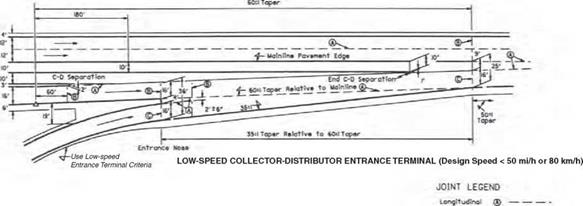MULTILANE RAMP AND ROADWAY TERMINALS AND TRANSITIONS
When two roadways converge or diverge, the less significant roadway should exit or enter on the right. Left-hand exits or entrances are contrary to driver expectancy and should be avoided wherever possible.
2.7.1 Multilane Entrance Ramps and Converging Roadways
Figure 2.46 shows recommended designs to be used for multilane entrance ramps and converging roadways. Converging roadways are defined as separate and nearly parallel roadways or ramps that combine into a single continuous roadway or ramp having a greater number of lanes beyond the nose than the number of lanes on either approach roadway. High-speed and low-speed entrance terminals should be used in lieu of converging roadway drawings when applicable. High-speed converging roadways should be used when either or both of the converging roadways are mainline roadways of an expressway or a freeway. Low-speed terminals should be used at the convergence of directional ramps within an interchange or at the convergence of interchange ramps with non-limited-access roads or streets. In general, low-speed terminals are applicable at all locations other than those requiring the use of high-speed terminals.
Lane Balance and Continuity. To avoid inside merges, the number of mainline lanes plus converging lanes approaching the nose must be equal to the resultant number of lanes leaving the nose. To make this possible, it is often necessary to carry additional mainline lanes past the nose for an adequate distance prior to tapering back to the desired number of lanes. These details are shown in Fig. 2.46.
Preferential Flow. In Fig. 2.46, one roadway in each design is labeled “preferential flow.” This indicates the more important of the two approaching traffic flows. In selecting the preferential flow, a designer must consider the effect of traffic volumes, number of lanes, the continuity and importance of signed routes, vehicle speeds, and roadway alignment. Lanes carrying the preferential flow are given the higher design treatment. When it is necessary to reduce a number of converging lanes or where an angular change in direction must occur, the design should favor the preferential flow.
Horizontal Curvature. Horizontal curves of roadways approaching the terminal nose should conform to mainline roadway criteria in the case of mainline roadways and to ramp entrance terminal criteria in the case of ramps.
|
|

2
 |
|
LANE EXIT FROM 4 LANES
|
|
|
|
|
|

![]() * Not9* the number of tones leaving the converging nose must be equal to the total nuntber of tones (converging plus main I line I approaching the nose.
* Not9* the number of tones leaving the converging nose must be equal to the total nuntber of tones (converging plus main I line I approaching the nose.
|
Crest Vertical Curves. Crest vertical curves on constant-width roadways approaching the merging nose should be designed to provide sight distance consistent with the design speed of the roadway. Crest vertical curves from the merging nose forward to a point where pavement convergence ceases, and to the converging portion of an approaching roadway where the number of lanes is being reduced in advance of the nose, should be designed using stopping sight distance values 25 percent higher than shown in Table 2.18. When design speeds differ on approaching roadways, the higher of the two design speeds should be used in designing the crest vertical curve beyond the merging nose.
Superelevation and Joint Location. Superelevation in the terminal area should be designed in accordance with the guidelines given for single-lane ramp terminals. Longitudinal joints should be located so they will coincide with and define the lane lines.










Leave a reply